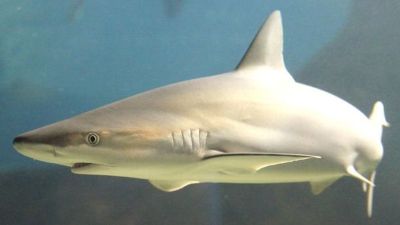Home › Sea Wildlife Facts › Marine › Vertebrates › Sharks › Blacknose Shark
Interesting Facts about Blacknose Sharks
[Phylum: Chordata] [Class: Chondrichthyes] [Order: Carcharhiniformes] [Family: Carcharhinidae]
The blacknose shark (Carcharhinus acronotus) is one of the small, fast-swimming requiem sharks that inhabits the warm waters of the western Atlantic.
There is no interdorsal ridge, but they are easily recognised by the dark coloured blotch on the tip of the snout and they're often kept in large public aquariums.
Where Do Blacknose Sharks Live in the Sea
Blacknose sharks are strictly a western Atlantic species, typically found in only a few select areas, such as:
- North Carolina (including the South Atlantic Bight)
- The Caribbean Sea (Antigua, Bahamas, Barbados, Belize, Curaçao)
- Gulf of Mexico (Campeche, Quintana Roo, Yucatán)
- Venezuela and southern coast of Brazil (including Uruguay)
The preferred habitats are warmer, shallow coastal waters (above 20° Celsius) and insular shelves that border coral reefs and sandy flats.
Young blacknose sharks are mostly confined to their nursery areas in seagrass beds and coastal lagoons shallower than thirty (30) metres (100 feet).
The adults inhabit much deeper environments (neritic zones), often to depths approaching 65 metres (around 210 feet).
Even so, it is a shark classification that develops better around sandy, shell hash rubble, or muddy bottoms, close to coral reef networks or rocky outcrops.
Blacknose Shark Characteristics
Unlike some solitary types of sharks, Carcharhinus acronotus are lively, fast-swimming predators that sometimes gather in small groups to hunt for anchovies and mullet.
The slender body of the blacknose shark is especially streamlined. They have large eyes located above a long and rounded snout, and sharp, serrated, triangular teeth that slant backward.
Nonetheless, the physical feature that makes these sharks easily identifiable is the dark smudge (almost black) on the snout, although less obvious in mature adults.
But wait - there's more:
They lack an interdorsal ridge, and their pectoral fins are relatively small. The first dorsal fin is short and stout with dark tips in the rear, and the second dorsal is slightly larger.
 Blacknose sharks are mostly a gray colour on the upper back, although it can appear somewhat greenish in broad daylight.
Blacknose sharks are mostly a gray colour on the upper back, although it can appear somewhat greenish in broad daylight.
However, the overall body colouration fades to a pale white on the underside.
The young are about fifty (50) centimetres long at birth (20 inches).
But, it's rare for this mid-level predator to grow much bigger than 130 centimetres in total body length - even after they reach full maturity.
Interesting Fact: Blacknose sharks are not aggressive, and unlike some members in our list of sharks, there are no reports of attacks on humans. However, they are capable of 'hunching' their back and lowering their caudal fin (agonistic behaviour) if they feel threatened.
What Do Blacknose Sharks Eat?
Their agility and speed gives them a distinct advantage when they need to hunt for food, especially against some of their closest rivals - Caribbean reef sharks (Carcharhinus perezi).
In general, the staple diet will include small bony fishes, such as boxfishes, croakers, grunts, porgies, spiny-finned pinfish, along with a healthy mix of benthic crustaceans and cephalopods.
Blacknose Shark Reproduction
They can live for up to ten (10) years outside of captivity. But, this particular shark genus breeds in alternate years once they reach sexual maturity around the age of two (2).
Being viviparous animals means they give birth to live young after the embryos have developed inside the mother. A placental connection provides the embryos with nourishment.
The gestation period usually lasts for ten months and the female blacknose shark typically produces between three (3) and six (6) pups per litter.
Predators and Threats
Predation in blacknose sharks comes from some of the largest sharks, especially bull sharks (Carcharhinus leucas) and tiger sharks (Galeocerdo cuvier).
That being said, other significant threats come from bycatch, ocean pollution, habitat degradation, and commercial and recreational fisheries.
Important: In 2019, the IUCN Red List of Threatened Species assessed the conservation status of the blacknose shark (Carcharhinus acronotus) as "Endangered" (EN) with a "Decreasing" population trend.